Knitting peeps are my favorite!!

Happy Easter to one and all!!

Knitting peeps are my favorite!!

Happy Easter to one and all!!
My mind tends to wander when I knit — often to the next “must have” project. So, when the new issue of Vogue Knitting hit my mailbox, I was excited to flip through it.

Hmmm. Mayhaps a trip to ye olde magazine shoppe is in order. It looks a bit worse for wear. I can’t even read most of the first half.
In the meantime, I’m plugging away on Cathedral. I should have done something slightly differently on the back, which I sort of knew at the time but did nothing about. Le sigh. I have “fixed” it for the front, however. What was my mistake?
Many Japanese patterns that have waist shaping do all of the shaping on one row. Instead of graduated decreases, all stitches will be removed by doing staggered decreases across a row. Later, the stitches will be added back by doing “make ones” in one row. Now, the problem with doing a lot of “make ones” in one row is that each time you increase, you are shortening, and therefore tightening up, the running thread that runs between the stitches. That’s fine if you are doing a few increases here and there. Doing multiple increases on the same row can look a bit off.
In my sweater, I needed to decrease and then increase 20 stitches in the shaping rows. This was charted to be accomplished on the five-stitch reverse stockinette panels that separate the two different patterns. On the decrease row, those five stitches go down to three. On the increase row, you make one, purl three, make one to go back to five. When I did that on the back, you can see where the increases occurred. (In the photo, the double pointed needle points to the line to help you see it better.)

When you look at the piece as a whole, it’s not that noticeable but it bothers me. So, when I did the increases for the front, I changed my technique. On the wrong side row before the increase row, I inserted a yarnover in the middle of each set of three stitches. I did that to increase the amount of running thread I had to work with when I came back to do the increases. On the increase row itself, I worked to the three reverse stockinette stitches. I slipped the first one to the right hand needle so I could “reach” the yarnover. I let the yarnover drop off the needle, and then manipulated the extra yarn so it was spread out over the three stitches. I placed the slipped stitch back on the left hand needle, and then worked the increases. (I hope I am making sense.)
Here is what the increases look like on the front. It’s a bit harder to see b/c the piece is still on the needle, but once it’s finished and blocked there should be no line at all.

My first wish would be that any knitting project I am interested in would take one day, and one day only, to knit. In that way, I might possibly be able to experience ALL of the fun projects that I find on Ravelry, in books, in my knitting group or LYS. It is extremely frustrating to be confined by the limits of time.
Case in point.

This book arrived a couple of days ago — it is a very nice book. Fun read, cute patterns, etc. There are several socks both Sally and I would like to make, but I am currently trapped by Ode to Joy. And I do mean trapped. The never ending sleeve scenario has bogged me down. My arms are inhumanly long — or so it seems when you are knitting to cover them up.
I did find some fabric for a summer frock — not perfect (it’s a little “out there”) but certainly workable for one of the two I would like to have on hand to wear with my OtJ this summer:

My next choice will definitely be more subdued. I’m thinking solid linen or cotton. Ahhh, another quest!
Now, back to the Genie: my second wish would follow this “WTF?” moment this morning:

Wish #2 — no snow in April, May, June, July, August, September, or October!!
And, my third wish is none of your beeswax! ![]()
I’m glad so many of you found my counting tips helpful, though I left out a really important part of the explanation that shows why this method is easier than flipping row counters and marking hash marks after every row.
For the following to make sense (and probably a lot of you already understood what I was trying to say!), you’ll need to read yesterday’s post first.
In the example from yesterday, we are doing sleeve increases every 6 rows and using waste yarn to mark when the increases are done. Once you have worked 6 rows above the waste yarn, you do the next increase, right?
BUT, how am I supposed to keep track of those 6 rows — by using a row counter or hash marks? How is that helpful or easier? This is where your knitting does the work for you. All you do is count the “ladders” above the waste yarn (i.e., running thread) between sts and you can see when the 6 rows are done and you are ready for the next increase:
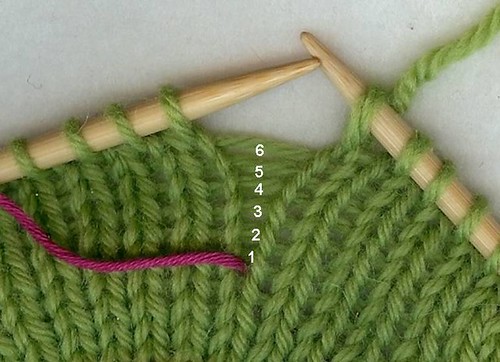
On the reverse side, you can count bumps.
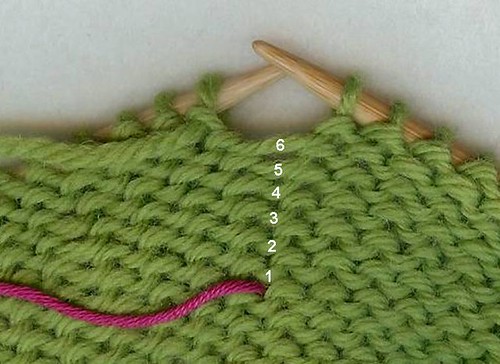
With garter stitch, I count ridges.

So, I do count something — but it’s my knitting that is keeping track for me.
Thanks for putting up with more on this topic!
PS — Jen had this question:
“I wasn’t confused before, but now I am. If you’re increasing every 6 rows, and count 6 ladders and THEN increase, doesn’t that mean you’re increasing every 7th row? Have I been doing this wrong all along? I thought Increasing every 6 rows meant increasing every sixth row and not having 6 rows between each increase row.”
Jen, you are correct and what I am doing is exactly what you have been doing. The first ladder is created on the row you actually do the increase = row 1 of the 6 rows in question. Then you knit 5 plain rounds. This equals the 6 ladders. The next row is an increase row again: row 1 of the next 6.
You could move your waste yarn from front to back (or back to front) on the row after you complete the increase, and then work 5 rows plain with the last row of the 6 being the increase row. I just find it easier to move the waste yarn on the row that I do the thing I am counting, so I don’t forget.
Wow — Sally’s new Japanese sweater is a tough act to follow, so I won’t even try. Her sweater is absolutely stunning, and I can’t wait to see it in person. I will be doing that soon, as I head east for another foray into the exciting world of the Maryland Sheep and Wool Festival — first weekend in May!!
So, what have I been up to? I have been working on Sleeve #1 of my Ode to Joy and also doing the prep work for the upcoming knitters guild program. The sleeve seems particularly slow, even for a sleeve. Could it be because I need to add 60 rows to obtain the length I need? Hmmm, maybe.
Since my knitting life is far more boring than Surly’s, I thought I would share a couple of tricks I have gleaned over the years.
Counting 1-2-3
Many steps in the knitting process require counting: counting rows between cable crossings, increases, decreases, etc. This requires keeping track of said counting. Row counters that have to be turned, hash marks that have to be written down, will all fail you because they rely on you remembering to do something. Each and every time. No forgetting. Ever. And I have found that I am not reliable! So I have learned to let my knitting to do the counting for me.
Your knitting will never lie to you.
Counting Rows with Waste Yarn
My favorite method for counting rows has been mentioned many times on our blog. It is one of the best tips of the trade I have ever found (Sally likes it, too).
Let’s use the example of sleeve increases. They are done every “x” number of rows. In our example, let’s say the increases are to be done every 6 rows.
On the row that you do the first increase, you ** work the increase and knit a few sts. Place the waste yarn between the stitch you just worked (the last st on the RH needle) and the next one to be worked (1st stitch on the LH needle). Yep. it just lays there between the two sts. Now knit the row normally, working the second increase at the end of the row.
The running thread of the row you just worked will hold the waste yarn in place and counts as one row. Work 5 more rows. Now there are 6 rows above the point where the waste yarn was placed. Since we are doing our increases every 6 rows, it is time to do another increase. Repeat from **, weaving the waste yarn from front to back, or back to front (this step alternates), on each row that an increase is made. If I forget to weave the waste yarn — I just pull it through under the running thread on the next row.
Your knitting will look like the sleeve shown here:
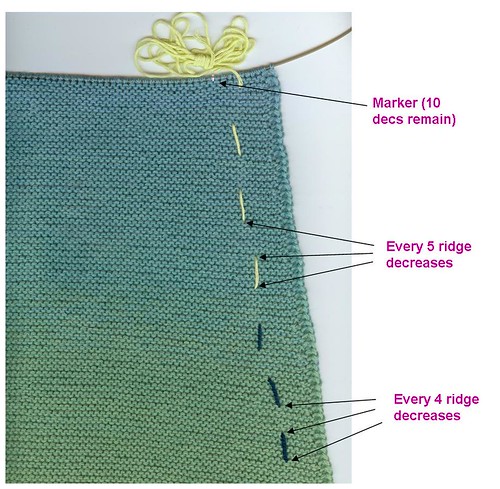
Each “slash” represents 2 decreases — here you see 6 decs every 4 ridges and 7 every 5 ridges
I am doing decreases because this is a top down sleeve, but the principle is the same.
I changed the color of my waste yarn to show where I changed from every 4th to every 5th ridge decs, though this is not really necessary. I do not remove the waste yarn when I’m done with the first sleeve — it tells the sleeve’s story. What happens if I get side tracked on a project? Can’t find my notes? Put the project away for months (years??!!) and now I want to start the second sleeve? My waste yarn tells the story.
Counting Increases with Markers
The other thing I do is something I started out of necessity: I really must get distracted easily — like, before I get to the end of the row! ![]() Have you ever forgotten to do the second increase (decrease) on a sleeve? You eventually count your sts and find out the count is off.
Have you ever forgotten to do the second increase (decrease) on a sleeve? You eventually count your sts and find out the count is off.
Where is the missing stitch? You look carefully along each edge and BINGO. There it is (or should I say isn’t). Back about 5 inches on the left hand side of the sleeve! You have two choices: rip back (ugh) or fudge and add the stitch. The fudged sleeve will end up a bit funky, and you’ll always know the mistake is there (ugh).
To avoid this, I use stitch markers to show how many increases (or decreases) I actually did vs how many I was supposed to do. For a bottom-up sleeve, after a few rows and increases, I place markers to mark off my original sts. The increases will be on either side of the markers.
The number of sts on each side of the markers must always be equal and always equal to the number of increases indicated by my waste yarn (3-3-3, 10-10-10…always equal). I count these sts every so often — if the numbers don’t match, I catch it early and don’t have much ripping to do.
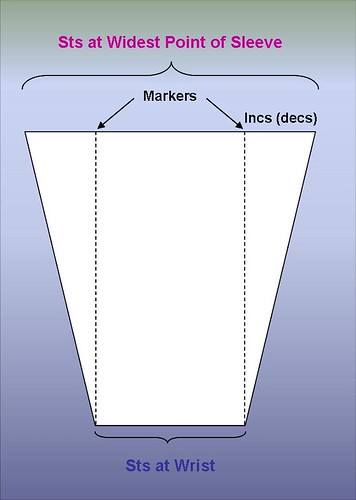
With top down sleeves, you start at the widest point in the sleeve. The markers show where you will end up and the total number of decreases will be on either side of the markers. As you work the sleeve decreases, the number of completed decreases (indicated by your waste yarn) plus the remaining sts on each side of the markers, need to equal the total number of decs.
Whew! This is a lot of writing for a very easy concept. I hope you find it useful. I know it has saved me a lot of time, stress, and concentration.
I can count without counting! ![]() Now you know exactly how lazy I am!!
Now you know exactly how lazy I am!!
I have a fairly good-sized yarn stash. It’s not as large as the stashes of some knitters I know (I’m looking at you, Marsha), but it’s large enough that I could knit for many years without ever needing to buy more. I will buy more, however; I fall in love easily. Some yarn in my stash is so precious that I’m almost afraid to knit with it. What if it’s not the absolutely perfect yarn for that project and the yarn is wasted? What if the yarn, adored sometimes for years, isn’t as wonderful as I thought once I start knitting with it? Could I stand the disappointment? So my twenty skeins of pale pink Mulberry Silk wait patiently in a cubby, as do six skeins of handpainted silk that make me think of Egyptian Pharaohs, countless skeins of gorgeous Koigu, and a few other prizes.
Along with those yarns, I’ve been carefully guarding 17 skeins of Jaeger Cashmina in a beautiful cinnamon brown crossed with bronze. I bought it in Scotland, at the John Lewis department store in Edinburgh. I had no idea what I was going to do with it. I bought every skein they had in that color and dye lot. Each skein came in its own little museum box.

See? How could you not love it?
In the past year or so, my grip on all of these yarns has loosened a bit. I’ve come to realize that while it’s fine to keep some yarns just for admiring or loving, life is short and it’s a bit senseless to deprive oneself of knitting joy. So, the Cashmina has come out to play. I found another Japanese pattern that I loved, and I decided that the Cashmina is perfect for it. It’s from the Let’s Knit Series 13. Here is the photo from the book.

I wanted to start it when I was supposed to be finishing my Bohus. I did let myself swatch, but managed to restrain myself until the Bohus was off the needles.
I finished the back this morning.

Sleeves are fun. Going to the dentist is fun. Tax time is fun. You think I’m kidding, right? Au contraire!! My Ode to Joy sleeve is going fine: enough going on with the color changes and decreases to not be boring. Last trip to the dentist, my youngest daughter got her braces off and looks grown up and gorgeous, and my taxes are organized and ready for the tax guy!
I stopped by The Yarnery yesterday and picked up the latest Rowan Magazine (#45). Quite beautiful! It has a combination of Asian-inspired designs and hippy flashbacks. The hippy stuff is not my taste. Sally liked the cap-shawl inspired wrap with sleeves in Kidsilk Haze called Honeysuckle.
OMG! The Bohus is absolutely gorgeous! Congratulations, and Happy Bloggiversary! No fanfare this year, but we are both happy to have been blogging with you for the past three years! 🙂
My Large Lace Collar is finally completely finished! It’s a beautiful pattern, beautiful yarn, but I’m a slow knitter. As much as I love my Bohus, I’ll be very happy to work on something else without a black cloud of guilt, merino, and angora hanging over my head.
I apologize in advance for the quality of today’s pictures. The lighting is not ideal for photography today. This is a soft, subtle project, which makes it even harder to capture properly. It gets a bit lost in translation. However, I’ll subject you to them anyway (even though you might be getting as tired of this project as I was).


A rare shot of an actual person in the sweater:

Here are some close up views of the hem and cuff:


For those of you who appreciate the technical details, here is a photo of the underarm. Look, ma, no seams! (Note the little white hairs; DNA from my little assistant.)

Here’s a photograph of the wrong side of the yoke for the more prurient knitters out there. (You know who you are.)

Finally, one last shot of the yoke.

So pretty. Le sigh.
I already AM a wiener! I won a book tonight at the Knitters Guild meeting — it’s a really lovely book with some great patterns.
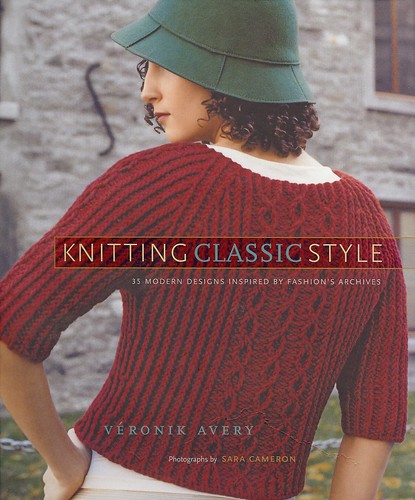
Knitting Classic Style by Veronik Avery
It has a little bit of everything: sweaters, vests, socks, gloves, wraps, styles for all ages, fair isle, lace, cables, beads. There are several patterns that piqued my interest. Woo Hoo!!
Veronik has done a lot of designing for Interweave Knits, and she has several designs that you would (might?) recognize:



So, it was a nice St. Patty’s Day! Hope yours was great, too, and sober!






PS — the blog title refers to an old cartoon that was one of my favorites. It shows a hot dog mailing an envelope that reads…yes, you guessed it, “You may already be a wiener!”
Powered by WordPress